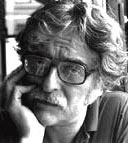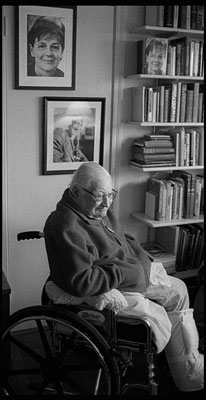 |
→ September 2004 Contents → Column
|
Nuts and Bolts
September 2004
|
 |
|||
|
On Monday, August 16th, Carl Mydans spent the day with his best friend, Bill Foley; Sonia Brown, the caregiver who had also become his friend; Karen Schwartz, the social worker who had worked with and cared for Carl and his wife, Shelley, for the past few years; his son, Seth, Bangkok bureau chief for The New York Times, and his daughter, Misty, a lawyer for the state of California. That evening, with his son and daughter, of whom he was so proud, at his bedside, Carl died. He was 97.
Perhaps because of the first professional years when he was a reporter in Boston and New York, perhaps because of what he learned as one of the photographers for the Farm Security Administration, Carl's pictures were simple and direct. Life magazine (he was the fifth photographer hired to be "staff") had gone beyond the "puppies-in-a-basket" photography, but was still highly pictorial. Weston, Cartier-Bresson, Strand, Evans and others who would contribute to a non-painterly school of photography weren't working for the weeklies. Carl was.
Carl's pictures are direct and unpretentious. You almost feel you could have taken them if you had been at the same event. And then you remember that, in many cases, there were other photographers at the same event, and nobody got the good images that Carl did.
Carl was direct and unpretentious.
All of the senior photographers on the 28th floor of the Time and Life Building helped the newcomers with their photography. Carl helped them with their lives.
I arrived on the 28th floor having spent a great deal of time with Gene Smith. What was dramatic in Gene's hands became melodramatic in my less-able hands. I was like one of those actors who waves his hands a lot, bellow and sometimes knock over the furniture. Attention getting? Yes. Good? No.
Carl taught me to learn about what I was going to photograph, to slow down and look at what I was photographing. And most of all, he taught me I shouldn't bellow and knock over the furniture. It was the subject's show.
Carl's records of what he photographed are a legend. His friends used Carl's daybooks the way other authors use the research room at a library. His diary of the world, his captions and general information on his assignments - all his assignments - are neatly filed in storage case after storage case in his home.
Not only was Carl a superb writer, but he encouraged others to write. Gordon Parks makes no secret of the fact that it was Carl's encouragement (i.e.: constant nagging and bullying) that started him writing. Today, Gordon is thought of as an exceptional photographer - and novelist and screenwriter and director.
I believe the last major news event that Carl covered was the ouster of Ferdinand and Imelda Marcos from the Philippines in 1986. I don't remember who told me this story; it may have been Susan Meiselas. Susan was also covering the overthrow of the Marcos government in the Philippines. She was looking for a high vantage point from which to shoot a street demonstration. She spotted a platform on a structure of poles and climbed it. It was a somewhat difficult climb. She was surprised and pleased when a hand reached down from the platform and took her camera bag and then pulled her to the top. It was Carl. He was 78. By the way, he also got exclusive pictures of Ferdinand and Imelda Marcos after they fled.
In his last years, Carl was wheelchair-bound and his sight and hearing were diminishing. No complaints. And an excitement, a curiosity and unbound joy when Bill Foley and Sonia Brown would take him off on a day trip adventure. What a remarkable man. What a great man.
I find myself sobbing. I'm surprised. Tears are rolling down my face because an old man's suffering has ended.
Carl closed his book, "More Than Meets the Eye," with this: "I cannot tell you where our history is leading us, or through what suffering, or into what era of war or peace. But, whatever it is, I know men of good heart will be passing there."
God bless you, Carl. We will miss you. Safe journey.
© Bill Pierce
Contributing Writer
|
||||
Back to September 2004 Contents |
|
